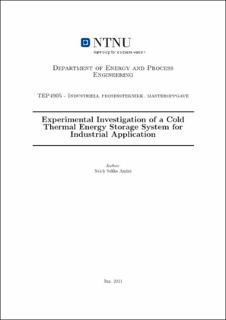| dc.description.abstract | Denne rapporten presenterer resultatene av eksperimentelle undersøkelser om ytelsen til et CTESsystem som er designet for ˚a integreres med et industrielt NH3/CO2 kaskadekjølesystem for et kjøttforedlingsanlegg for toppbarberingsform˚al. CTES best˚ar av en forseglet tank fylt med PCM og en stabel med 10 pute plate varmevekslere med mulighet for˚a endre avstanden mellom platene. Kjølemediet som ble brukt i dette eksperimentet var CO2. Eksperimentet besto av lade- og utladningssykluser som dikterer størkning og smelting av PCM. I løpet av disse syklusene ble hver av innløpet CO2 temperatur og strømningshastighet inn i platevarmevekslerne variert for ˚a kartlegge systemytelsen for to forskjellige konfigurasjoner som var 15 mm og 30 mm avstand mellom platevarmevekslerne. Eksperimentet ble kjørt med to forskjellige PCM-er med forskjellige egenskaper. De anvendte PCM-ene var vann og RT-9HC med henholdsvis 0 °C og smeltepunkt -9,7 °C. CTES-enheten fylt med vann som PCM hadde en lagringskapasitet p˚a 12,16 kW og 24,32 kW for henholdsvis 15 mm og 30 mm konfigurasjoner. CTES-enheten fylt med RT-9HC som PCM hadde en lagringskapasitet p˚a 7,27 kW og 14,54 kW for henholdsvis 15 mm og 30 mm konfigurasjoner. Begge PCM-ene viste seg ˚a være effektive under de rette forholdene for kjølemediumens strømningshastighet og dens innløpstemperatur og kan brukes til toppbarberingsform˚al. Vann kan brukes som PCM n˚ar systemet skal integreres for˚a gi kjøling mellom 6 °C og 10 °C. Dette kan f.eks. Brukes i kjøling av frukt og grønnsaker, eller romkjøling. RT-9HC som PCM kan integreres med et kjølesystem for ˚a gi kjøling mellom -4 °C og 4 °C. Under tømmingen er det nødvendig med en minimum temperaturforskjell p˚a 6 K mellom PCM og kjølemediet for systemet for˚a kunne trekke ut mer enn 70 % av den latente varmekapasiteten. For utslipp syntes en strømningshastighet p˚a 7 kg min−1 ˚a være optimal. Systemet viste seg ˚a være temperaturfølsomt der 1 °C forskjell i innløpet CO2 temperatur kan ha en enorm effekt p˚a hvor lenge systemet kan holde maksimal varmestrøm. Funn viser at den kumulative utladede energien i CTES var høyest n˚ar innløpet CO2 temperaturen i systemet var høyest. | |
| dc.description.abstract | Global warming is a reality that industries need to understand and work accordingly to limit by reducing their greenhouse gas emissions. Thermal energy consumption across industries varies greatly between peak and off-peak demand throughout the day and throughout the year. Refrigeration is a very energy-demanding process with huge variation in demand between peak hours and off-peak hours. This increases the load on the chillers and increases the capital cost due to the need of purchasing big equipment that can satisfy the varied demand for energy. Cold thermal energy storage (CTES) can be used to minimize the gap between the demand and supply of energy. Phase change materials (PCMs) use latent heat to store thermal energy storage which makes it an effective way of storing energy due to its high energy density. Literature review shows that extensive research has been done on integrating PCMs in buildings for different applications. These can be space cooling and heating, ventilation, and domestic hot water storage tanks. Furthermore, the use of TES for high-temperature applications such as solar energy applications is more spread compared with low-temperature applications. There has been an increased focus on the study of PCM-based CTES systems for small applications such as domestic refrigeration and air conditioning applications. However, there is a lack of study on CTES systems for large-scale industrial applications. This report presents the results of experimental investigations about the performance of a CTES system that is designed to be integrated with an industrial NH3/CO2 cascade refrigeration system for a meat processing plant for peak shaving purposes. The CTES consists of a sealed tank filled with PCM and a stack of 10 pillow plate heat exchangers with the possibility to change the distance between the plates. The refrigerant used in this experiment was CO2. The experiment consisted of charging and discharging cycles which dictate solidifying and melting the PCM. During these cycles, each of the inlet CO2 temperature and flow rate into the plate heat exchangers were varied in order to map out the system performance for two different configurations being 15 mm and 30 mm distance between the plate heat exchangers. The experiment was run using two different PCMs with different properties. The PCMs used were water and RT-9HC having 0 °C melting temperature and -9,7 °C, respectively. The CTES unit filled with water as the PCM had a storage capacity of 12,16 kW and 24,32 kW for the 15 mm and 30 mm configurations, respectively. The CTES unit filled with RT-9HC as the PCM had a storage capacity of 7,27 kW and 14,54 kW for the 15 mm and 30 mm configurations, respectively. Both PCMs proved to be efficient under the right conditions of the refrigerant flow rate and its inlet temperature and can be used for peak shaving purposes. Water can be used as the PCM when the system is to be integrated to provide cooling between 6 °and 10 °C. This can be utilized for example in fruits and vegetable cooling, or space cooling. The RT-9HC as a PCM can be integrated with a refrigeration system to provide cooling between -4 °C and 4 °C. During discharging, a minimum temperature difference of 6 K between the PCM and the refrigerant is needed for the system to be able to extract more than 70% of the latent heat capacity. For discharging, a flow rate of 7 kg min−1 seemed to be optimal. The system showed to be temperature sensitive where 1 °C difference in the inlet CO2 temperature can have a huge effect on how long the system can hold the maximum heat flow. Findings show that the cumulative discharged energy into the CTES was highest when the inlet CO2 temperature into the system was highest. | |
